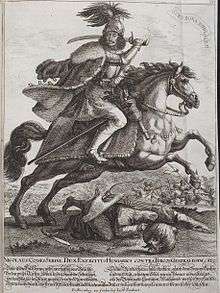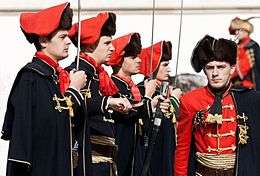Croats (military unit)
| Croats | |
|---|---|
| Active | 17th century |
| Country | Habsburg Monarchy |
| Allegiance |
|
| Branch | light cavalry |
| Type | auxiliary[1] |
| Role | off-battlefield |
| Equipment | Carbine and pistols |
| Engagements | |
| Commanders | |
| Initial structures | Count of Tilly |
| First regular regiments | Albrecht von Wallenstein |

The Croats or Crabats[6] (after Croatian Hrvat) were 17th-century light cavalry forces comparable to the Hussars.[7] The Croats were initially irregular units loosely organized in bands. The first regular Croat regiment was established in 1625.
The most notable engagement of the Croats was their participation on the side of the Catholic League in the Thirty Years' War. At the height of the Thirty Years' War, as many as 20,000 Croatian cavalry was in the service of the Imperial Army, including the majority of Wallenstein's Harquebusiers.
The name came to be used as a generic term for light cavalry from the area of the Habsburg Military Frontier rather than an ethnic designation, and besides Croats also included Hungarians, Serbs, Wallachians, Poles, Cossacks and Tatars.[7][8]
Initial structure
The Croats were initially recruited by generals of the Habsburg Monarchy.[9] The soldiers who joined Croats signed contracts which expired after the military campaign would be over, most often for any booty and sometimes for a fee.[7] At the beginning, their bands were loosely organized.[7] They were dismissed after the military campaign was finished and returned in the spring to be recruited by their old commanders.[7]
In 1623 the size of the Croat units under command of Count of Tilly was reduced from 172 hearths to 72.[1] They participated in the 1623 Battle of Stadtlohn under Tilly's command.[2]
Establishment of the regular units
The first regular Croat regiment was established in 1625 by Hector Ludwig Isolani, a military officer in service of Albrecht von Wallenstein.[7] Most commanders of the Croats were Hungarians.[6]
The duties of the Croats were mostly out of the battlefield because they did not have significant combat value.[6] In rare cases when they participated in the battle, they were engaged to confuse the enemy flanks by attacking their wings.[6] In many historical works the Croats are criticized for their cruel methods.[10] It has been reported that the worst atrocities during the Sack of Magdeburg were committed by the Croats and Walloons.[11] By the end of 1633 the Croats began their service in the army of the Kingdom of France.[9]
Equipment and uniform

The Croats wore hats made of fur and long red cloaks.[6][12] Their primary arms were carbines.[6] Besides carbine the Croat arms included two pistols.[13] The Croats wore scarves around their necks, probably for hygienic purposes.[14] During the Thirty Years' War the Croats came in contact with French who were impressed by their outfit and soon adopted the scarf, naming it after the Croats (French: cravate) which evolved into the modern-day cravat and necktie.[14] The Cravat Regiment is a guard of honour established in 2010 in Zagreb, Croatia, which wears uniforms that are replicas of those worn by the Croats.
Legacy
The influence of the Croat military unit was so strong that between 1631 and 1638 similar units were established in Bavaria, Spain and France.[7] At the beginning of the 20th century mothers still scared their children with tales about the 1631 Sack of Magdeburg in which Croats took part.[15] The population of eastern France compared all invasions after the Thirty Years' War with stories about Croats and Swedes who ravaged their territory in the 1630s.[16] Some prayers still contain text which says: "God save us from the plague, hunger, war and the Croats".[17] The Croats are mentioned in Grimmelshausen's Simplicissimus and in Friedrich Schiller's Wallenstein.[18]
References
- 1 2 Jr. 2009, p. 387.
- 1 2 Guthrie 2002, p. 113.
- ↑ Lunde 2014, p. 114.
- ↑ Brzezinski 2001, p. 23.
- ↑ Wilson 2009, p. 545.
- 1 2 3 4 5 6 Brzezinski 2001, p. 24.
- 1 2 3 4 5 6 7 Brnardic 2010, p. 38.
- ↑ Aladár Ballagi (1883), "Wallenstein’s kroatische Arkebusiere" (in German), Ungarische Revue (F. A. Brockhaus) 3: p. 716
- 1 2 Urban 2007, p. 122.
- ↑ Morris 2013, p. 60.
- ↑ Urban 2007, p. 107.
- ↑ Weir 2006, p. 71.
- ↑ Wilson 2009, p. 94.
- 1 2 Frucht 2004, p. 457.
- ↑ Weiss 2012, p. 10.
- ↑ Wilson 2009, p. 5.
- ↑ "Kravat pukovnija – od utemeljenja do danas". Retrieved 26 May 2015.
. Osim toga još i danas se ponegdje u molitvama sačuvala uzrečica: “Sačuvaj nas Bože kuge, gladi, rata i Hrvata!”
- ↑ Schiller 1861, p. 502.
Sources
- Van Antwerp Fine, Jr., John (1 January 2006). When Ethnicity Did Not Matter in the Balkans: A Study of Identity in Pre-Nationalist Croatia, Dalmatia, and Slavonia in the Medieval and Early-Modern Periods. University of Michigan Press. ISBN 0-472-02560-0.
- Brnardic, Vladimir (2010). Imperial Armies of the Thirty Years' War (2): Cavalry. Osprey Publishing. ISBN 978-1-84603-997-3.
- Schiller, Friedrich (1861). Complete works. Ed. with careful rev. and new tr., by C.J. Hempel.
- Laffan, Michael Francis; Weiss, Max (2012). Facing Fear: The History of an Emotion in Global Perspective. Princeton University Press. ISBN 0-691-15360-4.
- Kortüm, Hans-Henning (1 January 2006). Transcultural Wars: from the Middle Ages to the 21st Century. Walter de Gruyter. ISBN 978-3-05-004995-3.
- Lunde, Henrik O. (10 September 2014). A Warrior Dynasty: The Rise and Decline of Sweden as a Military Superpower. Casemate. ISBN 978-1-61200-243-9.
- Wilson, Peter Hamish (2009). The Thirty Years War: Europe's Tragedy. Harvard University Press. ISBN 978-0-674-03634-5.
- Brzezinski, Richard (2001). Lützen 1632: Climax of the Thirty Years War. Osprey Publishing. ISBN 978-1-85532-552-4.
- Morris, John E. (4 July 2013). A History of Modern Europe: From the Middle of the Sixteenth Century. Cambridge University Press. ISBN 978-1-107-62077-3.
- Jr., Thomas A. Brady (13 July 2009). German Histories in the Age of Reformations, 1400–1650. Cambridge University Press. ISBN 978-1-139-48115-1.
- Guthrie, William P. (2002). Battles of the Thirty Years War: From White Mountain to Nordlingen, 1618–1635. Greenwood Press. ISBN 978-0-313-32028-6.
- Weir, William (1 October 2006). Fatal Victories. Pegasus Books. ISBN 978-1-933648-12-5.
- Urban, William (1 July 2007). Bayonets For Hire: The U.S. Artillery from the Civil War to the Spanish–American War, 1861–1898. Frontline Books. ISBN 978-1-85367-742-7.
- Frucht, Richard C. (2004). Eastern Europe: an introduction to the people, lands, and culture. Vol. 2. ABC-CLIO. ISBN 978-1-57607-800-6.